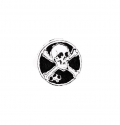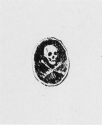The Paintings of James McNeill Whistler
M.1481
Skull and crossbones (b)

Date
Skull and crossbones dates from the autumn of 1896 and was given to William Heinemann (1863-1920), whose address is on the notepaper.

Skull and crossbones (b), Library of Congress
It is catalogued in MacDonald 1995 (cat. rais.) [more] (cat. no. 1481).
Images

Skull and crossbones (b), Library of Congress

Title page for 'A Book of Scoundrels' by Charles Whibley , Library of Congress

Skull and crossbones (a), Library of Congress

Proofs of Skull and crossbones, Library of Congress
Subject
Description

Skull and crossbones (b), Library of Congress
A skull and cross bones within a circular cartouche, signed with a butterfly.
Technique
Composition

Skull and crossbones (b), Library of Congress

Proofs of Skull and crossbones, Library of Congress

Title page for 'A Book of Scoundrels' by Charles Whibley , Library of Congress
Whistler designed the skull and crossbones motif for the title page of A Book of Scoundrels by Charles Whibley (1859-1930), published by William Heinemann (1863-1920) in London in 1896. It was used in pamphlets and press advertising Whibley's book. A press review of Whistler's book design reads: 'Much the same sort of triumph over difficulties is achieved by the title page vignette: a skull and cross-bones, with a cynically smiling mouth "shadow-grammed" over the teeth.' 1
Technique

Skull and crossbones (a), Library of Congress

Skull and crossbones (b), Library of Congress
Skull and crossbones m1480 is the first of two designs, and is unsigned; the second, Skull and crossbones m1481 is similar in design and paper, and signed with the butterfly.
History
Provenance
- 1896: probably sent by Whistler to William Heinemann (1863-1920), London;
- 1922: sold at auction, Heinemann sale, American Art Association, New York, 13 January 1922 (lot 243).
- 1920s: acquired by Elizabeth Robins Pennell (1855-1936) and Joseph Pennell (1860-1926);
- 1927/1936: given to the Library of Congress.
See MacDonald 1995 (cat. rais.) [more] (cat. no. 1480-1481).
Exhibitions
It was not exhibited in Whistler's lifetime.
Bibliography
Catalogues Raisonnés
- MacDonald, Margaret F., James McNeill Whistler. Drawings, Pastels and Watercolours. A Catalogue Raisonné, New Haven and London, 1995 (cat. no. 1481) as 'Skull and crossbones'.
Books, General
- Whibley, Charles, A Book of Scoundrels, London, 1897 (title page with design by Whistler).
Catalogues 1906-Present
SALE:
- Heinemann sale, American Art Association, New York, 13 January 1922 (lot 243).
Notes:
1: Advertisement and press-cutting in Pickford Waller's Presscutting Album, p. 79, Metropolitan Museum of Art.